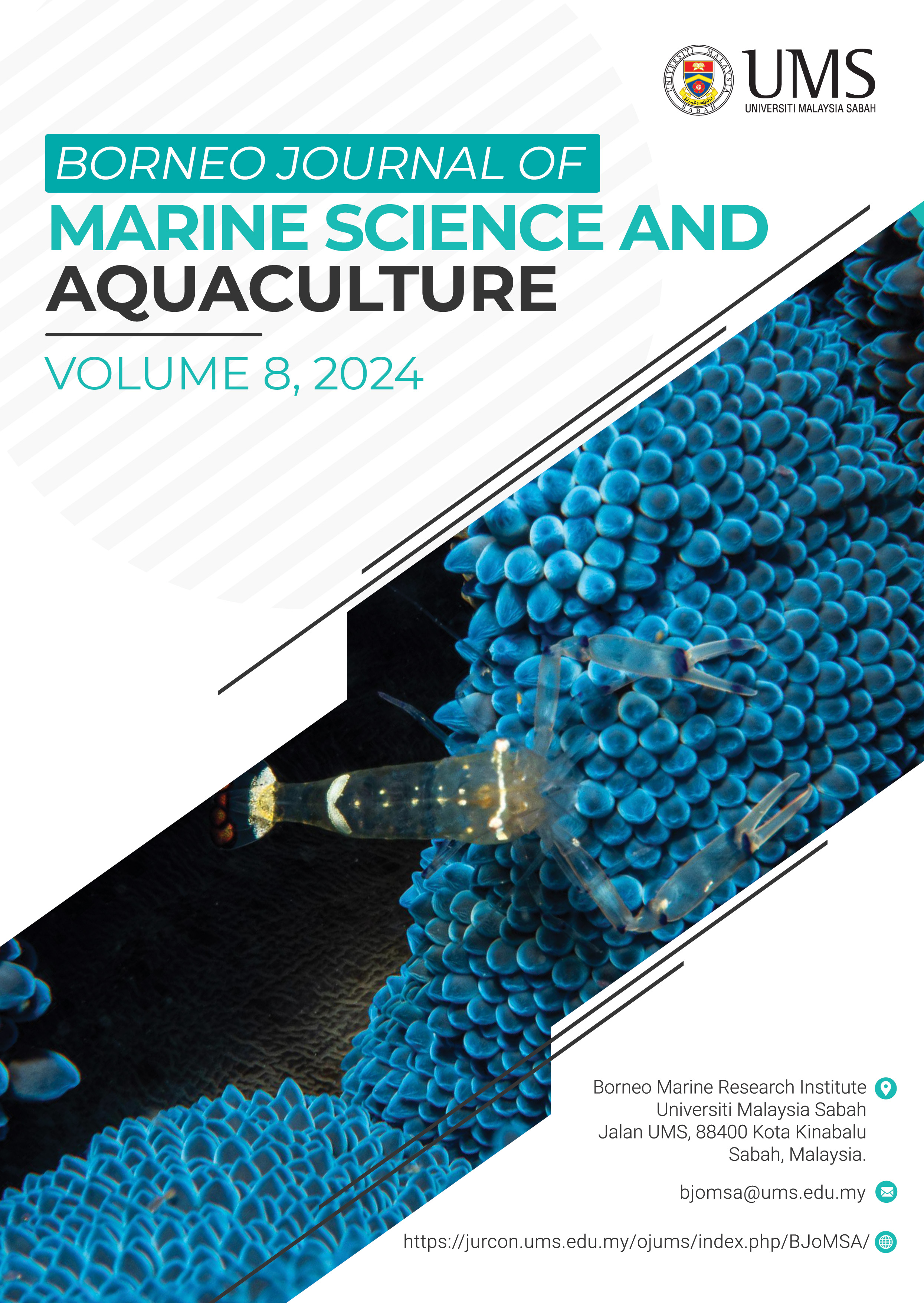Refining of Water Masses at Sarawak Waters, Malaysia
South China Sea water characteristics off Sarawak
DOI:
https://doi.org/10.51200/bjomsa.v8i.3892Keywords:
Vertical profiles, T-S diagram, water mass, Sarawak waters, South China SeaAbstract
Water mass identification is essential to understand the dynamics of water circulation. The waters off Sarawak are influenced by the northeast and the southwest monsoons. We studied the physical oceanography of the South China Sea along these waters, from data collected during the Prime Marine Scientific Expedition 2009. The expedition was organized by the Malaysian Ministry of Science, Technology, and Innovation through the National Oceanography Directorate. The physical properties of seawater were obtained using the 'Conductivity-Temperature-Depth' (CTD) profiler from the ocean surface to a water depth of 523 meters. Measurements were recorded from 62 stations, with the furthest offshore distance being approximately 471 kilometers from the nearest point of Sarawak's mainland. The aim of this study is to identify the mass features of Sarawak waters. We employed the T-S diagram and refined the water masses based on previous studies conducted in the South China Sea. The constructed vertical salinity and temperature profiles showed that salinity increases towards the sea bottom, whereas temperature decreases as water depth increases. Five water masses were identified off Sarawak waters, namely Continental Shelf Water (CSW), Open Sea Water (OSW), Maximum Salinity Water (MSW), Permanent Thermocline Water (PTW), and Water Mass 1 (WM1). WM1 is derived from the mix of OSW and MSW masses. Results of this study are useful for studies in primary productivity and the distribution of marine resources in these waters.
References
Arsad, S., & Akhir, M. F. (2013). The characteristics and origin of water masses along the Sabah coast. International Journal of Research in Earth and Environmental Science, 1(1): 35-43.
Akhir, M. F. (2012). Surface Circulation and Temperature Distribution of Southern South China Sea from Boonyapiwat, S. (1999). Distribution, Abundance and Species Composition of Phytoplankton in the South China Sea, Area II: Sabah, Sarawak and Brunei Darussalam in Proceedings of the Second Technical Seminar on Marine Fishery Resources Survey in the South China Sea, Area II: West Coast of Sabah, Sarawak and Brunei Darussalam on 14-15 December 1998, Kuala Lumpur, Malaysia.
Dippner, J. W. & Loick-Wilde, N. (2011). A redefinition of water masses in the Vietnamese upwelling area. Journal of Marine Systems, 84(1), 42-47.
Manson, A. A., Saleh, E., Mujahid. A, & Juneng, L. (2018). Temperature and Salinity Profiling Analysis off Sarawak Waters, Malaysia. Transactions on Science and Technology. 5 (3), 216 – 220.
Marghany, M. (2012). Intermonsoon water mass characteristics along coastal waters off Kuala Terengganu, Malaysia. International Journal of Physical Sciences, 7(8), 1294-1299.
O’Neil, B. G., & Eason, C. W. (1982). China Sea Pilot. Vol. II Hydrographer of the Navy, Hydrographic Department, Ministry of Defense, Somerset, England, 1982.
Qu, T., Mitsudera, H., & Yamagata, T. (1999). A climatology of the circulation and water mass distribution near the Philippine Coast. Journal of Physical Oceanography, 29(7), 1488-1505.
Qu, T., Mitsudera, H., & Yamagata, T. (2000). Intrusion of the North Pacific waters into the South China Sea. Journal of Geophysical Research: Oceans (1978–2012), 105(C3), 6415-6424.
Rojana-Anawat, P., Pradit, S., Sukramongkol, N., & Siriraksophon, S. (2001). Temperature, salinity, dissolved oxygen and water masses of Vietnamese waters. In Proceedings of the SEAFDEC seminar on fisheries resources in the South China Sea, Area. 4, 346-355.
Saadon, N., Kin, L. P., Snivdongs, A., & Rojana-anawat., P. (1998a). Physical characteristics of water-mass in the South China Sea, Area II: Sarawak, Sabah and Brunei Darussalam Water. In: First Technical Seminar on Marine Fishery Resources Survey in the South China Sea, Area I: Gulf of Thailand and east coast of Peninsula Malaysia (pp. 1-22).
Saadon, M. S., Liew, H. C. & Uchiyama. M. (1988b). Salinity and temperature vertical profiles off the Sarawak coast. Ekspedisi Matahari, 1(8), 29-36.
Siripong, A. (1984). Surface circulation in the Gulf of Thailand and South China Sea in 4 seasons from direct measurement in Proceeding of the Third Seminar on the Water Quality and Living Resources in Thai Waters.
Song, J., Mujahid, A., Po-Teen, L, Samah, A. A, Quack, A., Pfeilsticker, K., Sen-Lin, T, Ivanova, E. & Tomczak, M., & Godfrey, J. S. (1994). Regional oceanography: an introduction. Elsevier. Oxford.
Wyrtki, K. (1961). Physical oceanography of the Southeast Asian waters. Naga report. Scripps Institution of Oceanography. California.






